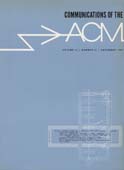December 1967 - Vol. 10 No. 12

Features
A multiprogramming environment for online data acquistion and analysis
An experimental system for acquisition and analysis of large bodies of data derived from scientific experiments is described. Its architecture and implementation is largely based on certain objectives and characteristics of a general data analysis scheme. Early applications have been oriented towards the investigation of data obtained in biological research. Some of the problems encountered by the chosen approach are discussed.
The LACONIQ monitor: time sharing for online dialogues
The LACONIQ (Laboratory Computer Online Inquiry) Monitor was developed primarily to support non-numerical applications such as retrieval from very large files by means of a “dialogue” between a system user and a retrieval application.
The monitor was designed so that it could work with a small computer (an IBM System 360/30). Therefore techniques for resource allocation were important. For this reason the use of core storage, computational facilities, and input-output were all scheduled.
An unusual feature of the system is that it is event-driven rather than clock-driven. The program segments called into execution by the remote CRT consoles are invariably run to completion rather than “rolled-out” to be brought back at a later time.
A system organization for resource allocation
This paper introduces a system for resource management using the concepts of “process,” “facility,” and “event.” Except for the processor no attempt has been made to give serious suggestions for the policy to be followed for resource allocation. However, a basic framework is provided in which a system analyst can express solutions to resource management problems.
The paper is divided into a tutorial presentation, a description of the system primitives, and a small collection of examples of the use of the primitives.
Algorithms for finding a fundamental set of cycles for an undirected linear graph
Given the adjacency matrix of the graph, the algorithm presented in this paper finds a spanning tree and then constructs the set of fundamental cycles. Our algorithm is slower than an algorithm presented by Welch by a ratio of N/3 (N is the number of nodes) but requires less storage. For graphs with a large number of nodes and edges, when storage is limited our algorithm is superior to Welch's; however, when the graphs are small, or machine storage is very large, Welch's algorithm is superior. Timing estimates and storage requirements for both methods are presented.
A SIMSCRIPT-FORTRAN case study
Two programs for a vehicle dispatching model, one written in 7040 SIMSCRIPT and the other in 7040 FORTRAN IV are compared. The comparison is made in terms of basic program design decisions, storage requirements, computer time used, and the ease of making changes.
In the SIMSCRIPT program, the primary design considerations center around the choice of model variables, model changing events, and model testing. In the FORTRAN program, basic design problems relate to the representation of the passage of time, the allocation of storage, and the organization of input data.
The comparison of these differently designed programs shows that the SIMSCRIPT program uses more computer storage and more computer time, but requires fewer program changes to introduce model revisions.
An online, interactive system for text editing is described in detail, with remarks on the theoretical and experimental justification for its form. Emphasis throughout the system is on providing maximum convenience and power for the user. Notable features are its ability to handle any piece of text, the content-searching facility, and the character-by-character editing operations. The editor can be programmed to a limited extent.
Eigenvectors of a 2n × 2n matrix
It has been known that the eigenvalues of a certain 2n × 2n matrix can be obtained by use of two smaller matrices of order n which can be easily constructed. An algorithm is given to obtain the eigenvectors of the 2n × 2n matrix by use of the eigenvectors of the smaller matrices.
The ALCOR Illinois 7090/7094 post mortem dump
A dump technique for programs written in ALGOL 60 is described. This technique provides an intelligible analysis of an unsuccessful computation process in terms of the original source program.
On the normalization requirement of divisor in divide-and-correct methods
This paper presents an analysis on the normalization requirement of the divisor in a divide-and-correct method. This analysis is made subject to the condition that not more than one correction is required to obtain the true quotient character, from the trial estimate got from the division of a two-precision segment of every partial remainder by a suitably rounded single-precision divisor. (This segmented division is denoted here as a (2, 1) precision basic division.) It is found that the normalization requirement could be narrowed down to a smaller range of divisors, provided the magnitude of the character next to the leading character of the divisor is known. If, however, the normalization is to be eliminated one has to choose proper higher precision segments of operands for the basic division.
Also considered is the possibility of eliminating the normalization by an increase on the number of corrections on the quotient estimate got from a (2, 1) precision basic division. It is shown that such a scheme is economical only for small radices.



